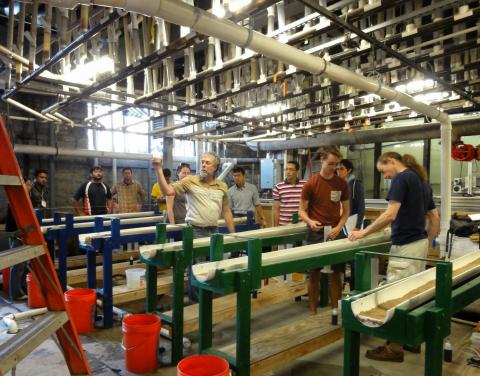This exercise was created by Gordon Grant and has been used at the NCED Summer Institute (SIESD) to introduce participants to physical modeling from 2010-2014.
Today's exercise is intended to provide an introduction to physical modeling of rivers, using a very simple experiment. Despite its apparent simplicity, however, the exercise will capture one of the most fundamental and powerful principles of channel adjustment: the concept of grade. You will be assigned to small groups of 4-5 individuals, and each group will have a simple flume with which to work. Tools, sediment, measuring devices, etc., will be provided.
The challenge: Conduct an experiment to demonstrate how a river responds to a change (increase) in sediment supply.
Methods:
- Find your flume. Each flume will be pre-loaded wih one of two sediment mixtures and a pre-set slope.
- Meaure initial bedslope, using instruments provided
- Use a 5 gallon pail to catch water and sand effluent
- Start water at some low rate and feed sand. Measure flow rate. See what it looks like. We want flow to be wall to wall and subcritical. If you see knickpoints and really dynamic activity you will need to relax the flow rate a bit. We want slowish deep (1-2 cm) flow instead of sheet flow.
- Select sediment feed rate and feed sand at a regular interval - 300 milliliters every 2 minutes is a suggestion. Do this until equilibrium is reached. Measure sediment outflow. Take some pictures. Measure slope.
- Increase feed rate x2 and repeat.
- Construct a data table and record your measurements.
Some questions to consider while you are conducting the experiment:
- What does "equilibrium" mean in the flume? What does it look like? Over what timescales does it occur?
- How does the scale of the flume experiment compare to a real river? Is the flume a model of a real river? If so, what are its dimensions? How would you cale the results to a larger river?
- What are the time and spatial scales over which adjustment to the changing load occurs? How might these scale to a "real" river?
- How would you predict in advance what the magnitude of adjustment was likely to be?
Set-up notes:
- Slopes of the channels were set before the experiment to 0.02.
- Our flumes were made of half-round PVC (6” diameter). Flumes were 2 m long. Pictures are attached that show some of the detail, including the water feed fitting (no separate dissipater was used). Note that the frame used to support the flumes needs to have support in the middle, not just at the ends; otherwise you get tectonics due to sediment loading and the flume bows down.
Attachments:
Photos:
